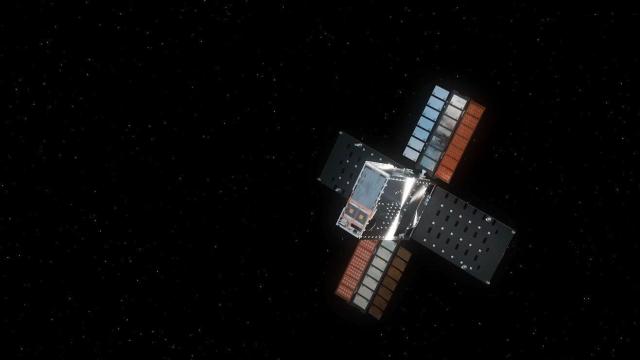For nearly five months, teams behind NASA’s Lunar Flashlight mission have been trying to get the briefcase-sized satellite to fire up its thrusters and get on the right orbital track around the Moon. There’s now some hope with one of the thrusters showing some improvement as work continues on the remaining three.
The Lunar Flashlight’s operations team has developed a new method to get the satellite’s propulsion system up and running, with the spacecraft needing more thrust within the next few days so that it can reach its revised orbit, NASA wrote in a blogpost on Friday.
Team members at NASA’s Jet Propulsion Laboratory in southern California, Georgia Tech, and the space agency’s Marshall Space Flight Centre in Huntsville, Alabama, are all working together on the new strategy, which involves “increasing fuel pump pressure far beyond the system’s operational limit while opening and closing the system’s valves,” according to NASA. The objective of this method is to attempt to remove any blockages from the thruster’s fuel lines, enabling the spacecraft to produce adequate thrust for carrying out monthly flybys of the Moon’s south polar region.
The mission engineers’ latest attempt focused on one of the cubesat’s thrusters and they are now attempting it on the other three. “This has resulted in limited success, with the remaining thrusters inconsistently producing some increased levels of thrust,” NASA wrote in the blogpost.
Lunar Flashlight launched aboard a Falcon 9 rocket alongside Japan’s Hakuto-R lunar lander mission in December 2022. Sadly, the Japanese private lander crashed on the Moon in April, failing to fulfil its mission. Its payload companion, on the other hand, is still trying to carry out its own mission.
Shortly after its launch, Lunar Flashlight ran into some trouble when three of its four thrusters began to underperform on account of those obstructed fuel lines. Lunar Flashlight was supposed to enter a near-rectilinear halo orbit around the Moon, but with the thruster problems, NASA hatched a plan to place the probe in a high Earth orbit instead, allowing it to scan the Moon’s south polar regions once per month, as opposed to the original plan of once per week.
The cubesat is currently more than half a million miles away from Earth and looping its way back toward our planet. Meanwhile, the mission team is trying to nudge the Lunar Flashlight into a “trajectory that will allow it to arrive in the required Earth-Moon orbit,” according to NASA.
The Lunar Flashlight is designed to shine infrared light on some of the Moon’s permanently shadowed regions, scanning the lunar South Pole for reservoirs of ice water hidden away from the Sun’s light. The small spacecraft is using a new kind of propulsion system as a technology demonstration in space, which always carries its own risk for the mission itself.
“Technology demonstrations are high-risk, high-reward endeavours intended to push the frontiers of space technology,” NASA wrote. “The lessons learned from these challenges will help to inform future missions that advance this technology.”
